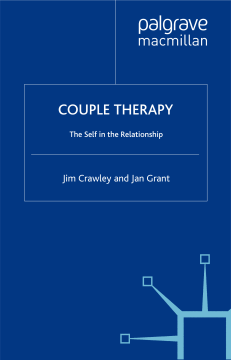
Additional Information
Book Details
Abstract
This book presents students and experienced practitioners alike with an accessible guide on the complex dynamics of the couple relationship. Combining the theoretical grounding of various psychodynamic fields of thought with vivid case studies, it advises on how to address issues such as domestic violence, affairs and the step-family system.
JIM CRAWLEY is a private practitioner of psychoanalytic psychotherapy in Western Australia. He was inaugural president of the Psychotherapy and Counselling Federation of Australia (PACFA); a senior lecturer teaching on the Master of Social Science (Counselling) course, at Edith Cowan University, Perth; and the executive director of the Marriage Guidance Council of Western Australia (now Relationships Australia WA). He is co-author of Transference and Projection: mirrors to the self and author of Couple Therapy in Australia: issues emerging from practice.
JAN GRANT is programme director of the Masters and PhD programmes in Counselling at Curtin University of Technology, Western Australia, and has a private psychotherapy practice. She is a member of the MA26 of Counselling Psychologists, APS, and is a past president of SCAPE. She is co-author of Transference and Projection: mirrors to the self and co-editor of Australian Journal of Counselling Psychology.
'Crawley and Grant have produced an excellent book on couple therapy...Experienced therapists will gain a lot from this book and those considering couple work training will find it an essential read.' Angela Cooper, Therapy Today
Table of Contents
| Section Title | Page | Action | Price |
|---|---|---|---|
| Cover | Cover | ||
| Contents | vii | ||
| Acknowledgements | ix | ||
| Introduction | 1 | ||
| 1 The Psychodynamics of the Couple Relationship: Object Relations Theory | 6 | ||
| Underlying principles of psychodynamic approaches to couples | 7 | ||
| Object relations approaches to couple therapy | 11 | ||
| Conclusion | 23 | ||
| 2 The Psychodynamics of the Couple Relationship: Self Psychology, Intersubjectivity, and Attachment Theory | 24 | ||
| Empathic immersion | 24 | ||
| Selfobject experiences and transferences | 25 | ||
| Narcissistic vulnerability, injury, and rage | 27 | ||
| Intersubjectivity | 29 | ||
| Treatment goals | 30 | ||
| Attachment theory and couple therapy | 32 | ||
| Love and the relational approaches | 37 | ||
| Conclusion | 39 | ||
| 3 Thinking Systemically About the Couple | 40 | ||
| Introduction | 40 | ||
| Some important family systems concepts | 40 | ||
| Bowen Theory | 48 | ||
| Relationship systems across time | 57 | ||
| Conclusion | 64 | ||
| 4 But What About Love? | 66 | ||
| Introduction | 66 | ||
| Emotion in the couple relationship | 67 | ||
| Sexuality and couple therapy | 72 | ||
| Conclusion | 80 | ||
| 5 Assessment | 81 | ||
| Getting started: Engagement or assessment? | 81 | ||
| The content of assessment: A five-dimensional framework | 83 | ||
| The structure of the assessment phase | 86 | ||
| The process of assessment | 90 | ||
| Conclusion | 98 | ||
| 6 Technique | 99 | ||
| The centrality of the therapeutic relationship: Creating 'an island of safety' | 99 | ||
| Conducting the conjoint session | 103 | ||
| Conclusion | 113 | ||
| 7 Therapeutic Process | 114 | ||
| Stages of therapy | 114 | ||
| Who do we talk to? Individual versus conjoint sessions | 117 | ||
| What do therapist and couple talk about in the conjoint session? | 120 | ||
| … and how do we talk about it? | 122 | ||
| Conclusion | 131 | ||
| 8 The Dynamics of Presenting Problems | 132 | ||
| Domestic violence | 132 | ||
| Affairs | 139 | ||
| The re-married couple with stepchildren | 147 | ||
| The polarized couple | 149 | ||
| Conclusion | 152 | ||
| Epilogue: Surviving as Couple Therapist | 153 | ||
| Research and couple therapy | 153 | ||
| Ethical considerations in couple therapy | 158 | ||
| Supervision and personal therapy for the couple therapist | 162 | ||
| Conclusion | 164 | ||
| References | 165 | ||
| Index | 177 |
